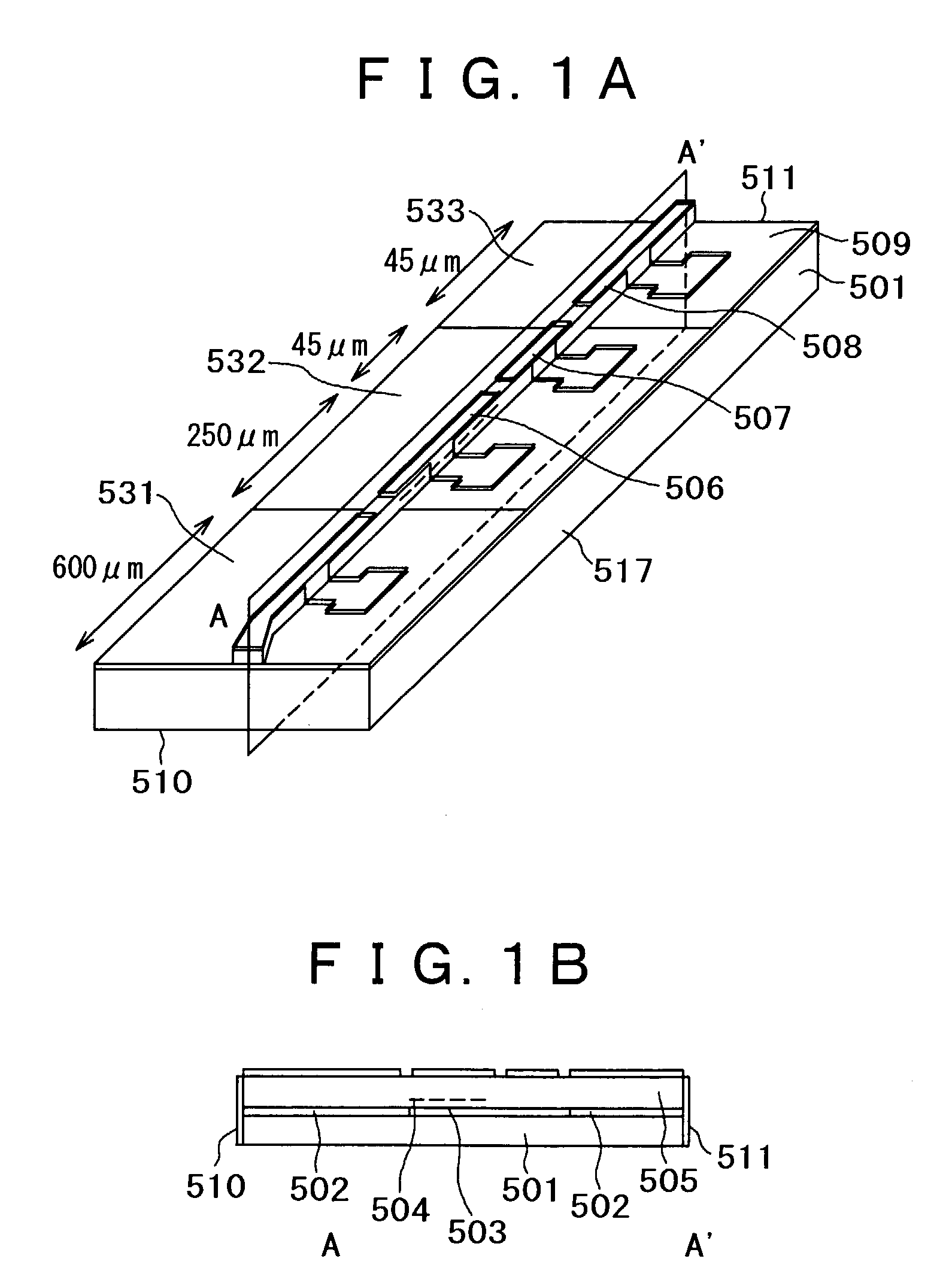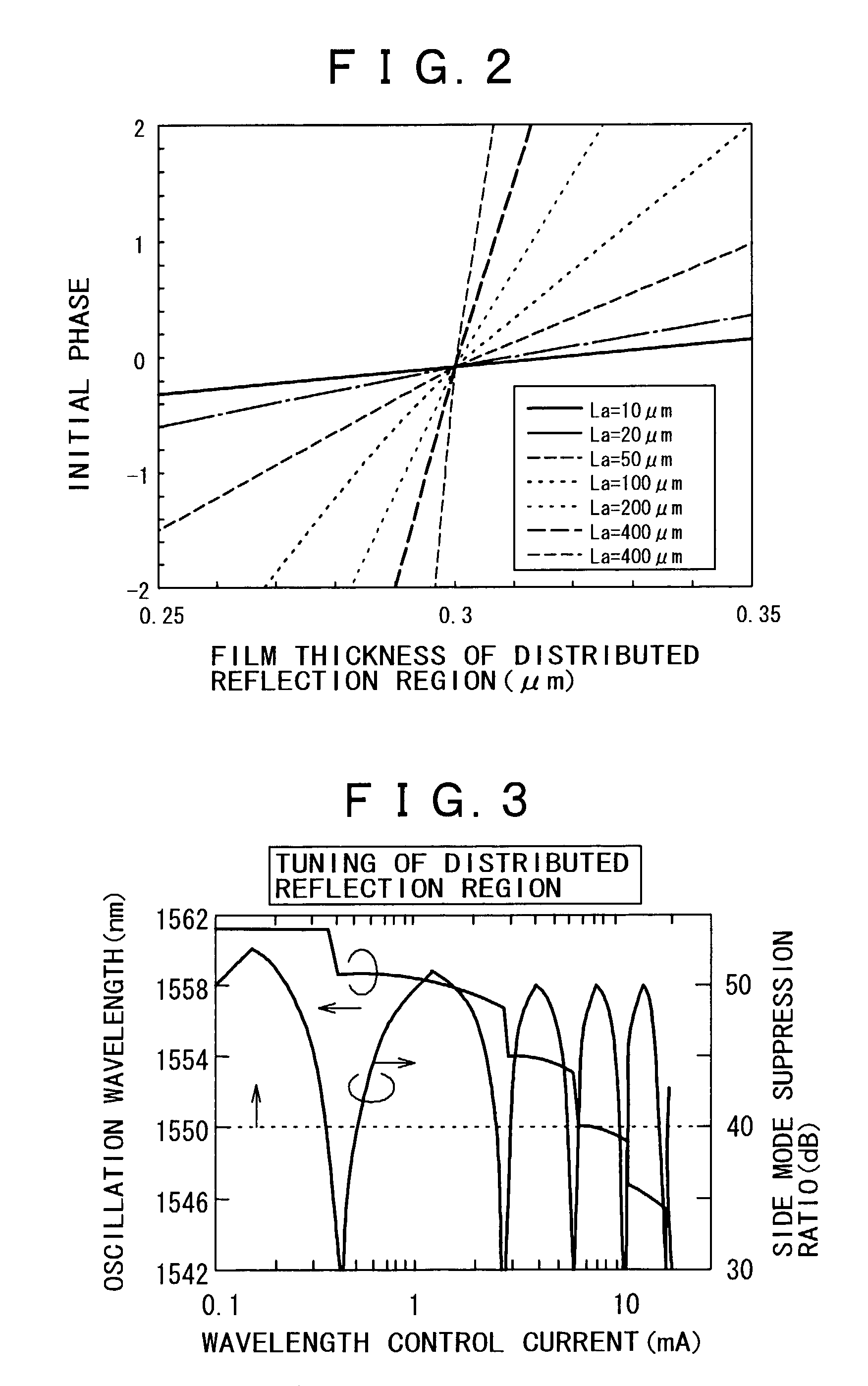Semiconductor laser apparatus
a laser and semiconductor technology, applied in the direction of semiconductor laser arrangement, semiconductor laser, optical resonator shape and construction, etc., can solve the problems of limited wavelength range, response speed, and further complicated control circuits, and achieve stable longitudinal-mode operation, suppress longitudinal-mode hopping, and excel wavelength stability
- Summary
- Abstract
- Description
- Claims
- Application Information
AI Technical Summary
Benefits of technology
Problems solved by technology
Method used
Image
Examples
embodiment 1
[0025]FIG. 1 is a view showing an example of fabrication of the semiconductor laser in which a 1.55 μm band distributed reflection type laser and an optical amplifier are integrated according to a first preferred embodiment of the present invention and whose oscillation wavelength can be varied with the electric signal. Continuous tunable wavelength characteristics of the distributed reflection type laser are determined by the longitudinal-mode hopping of the laser. The interval of the laser longitudinal-mode hopping ΔλDBR is dependent on a region length L and is given by the equation:
ΔλDBR=λ2 / 2(naLa+npLp) (1)
[0026]Here, λ denotes the oscillation wavelength, n denotes the optical refractive index of the laser medium, and suffixes (a) and (p) represent an active region and a phase adjustment region, respectively. The expression has a close relation to a fact that phase variation quantity Δφt of the laser oscillation mode in the active region accompanying a wavelength variation of Δλ...
embodiment 2
[0038]FIGS. 6A and 6B show a laser having a structure similar to that of the preferred Embodiment 1, wherein the active region length is shortened to 33 μm to effect expansion of the continuous tunable wavelength range. A basic structure and fabrication of the device are almost similar to those of Embodiment 1. The main differences in designing the laser are the following points: (1) an optical coupling coefficient of the diffraction grating was enlarged to 200 cm−1 in order to compensate for the decrease in laser gain that accompanied the shortening of the active region, and (2) the distributed reflector is made to be such that the phases of two diffraction grating regions located in front of and in the rear of the active layer are reversed to each other, realizing the so-called λ / 4 phase-shift type grating, in order to stabilize the single axial mode oscillation in the vicinity of the Bragg wavelength.
[0039]With the laser according to this preferred embodiment of the present inven...
embodiment 3
[0041]FIG. 7 shows a configuration shown in Embodiment 2, wherein four distributed reflection lasers 805 each having a different wavelength range are integrated into an array in a side by side manner. Using a known 4×1 optical multiplexer 804 that uses a multi-mode interference waveguide, the outputs of the lasers are guided to an optical amplifier 803 that is monolithically integrated with an output waveguide thereof. In this preferred configuration, a different point from the configuration of the conventional distributed feedback laser array is that, as shown in the figure, wavelength controlling terminals 807 and phase controlling terminals 806 of the lasers are connected to common terminals, respectively. This configuration becomes feasible for the following reasons: (1) two or more lasers are not operated simultaneously, and (2) dead current is an order of 90 mA or less at a maximum because the wavelength controlling current and the phase controlling current are 30 mA or less, ...
PUM
 Login to View More
Login to View More Abstract
Description
Claims
Application Information
 Login to View More
Login to View More - R&D
- Intellectual Property
- Life Sciences
- Materials
- Tech Scout
- Unparalleled Data Quality
- Higher Quality Content
- 60% Fewer Hallucinations
Browse by: Latest US Patents, China's latest patents, Technical Efficacy Thesaurus, Application Domain, Technology Topic, Popular Technical Reports.
© 2025 PatSnap. All rights reserved.Legal|Privacy policy|Modern Slavery Act Transparency Statement|Sitemap|About US| Contact US: help@patsnap.com



